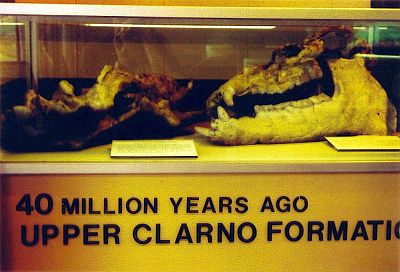Science: The unreliable historian
She made the discovery of the century … and did not want to tell anyone!

In 2005, Dr Mary Schweitzer published in Science1 what could be described as the scientific discovery of the century. When interviewed by 60 Minutes she described her internal reaction to her amazing discovery, “I didn’t want to tell anyone.” The interviewer fed her a possible motivation for this unusual reaction, “… you would be ridiculed, right?” She responded, “Yes.”2
A scientific breakthrough that one does not want to report … What is that all about?
Dr Schweitzer was associated with a project to unearth T.rex fossil bones from the oldest-known rock layer bearing these giants. This was a 68 million-year-old formation. The femur bone was too large for the helicopter to lift and had to be sliced in half for removal from its remote location. Dr Schweitzer was sent fragments from the split femur bone. She instructed her technician to use a mild chemical solution to dissolve the fossilized bone from a small slice of the specimen. What was left behind was actual dinosaur soft tissue. She had actual T.rex tissue! This was impossible since all soft tissue encased in fossilized bone should have been decayed within 10,000 years of burial. Certainly, by 100,000 years, not even a trace of soft tissue should be left.3
As the discovery went forward she identified dinosaur proteins and what appeared to be blood vessels with nucleated red blood cells in them. On MSNBC she is quoted as saying this about her discovery, “It’s utterly shocking, actually, because it flies in the face of everything we understand about how tissues and cells degrade.” She went on to say, “A lot of our science doesn’t allow for this… it just doesn’t seem possible… I can’t explain it, to be honest.” She has since found soft tissue in other fossilized bones… even ‘older’ than the T.rex.4
The problem with her discovery is that it is absolutely impossible for soft tissue to remain intact inside fossil bone for much over 10,000 years, let alone a million years. This sample is supposedly 68 million years old. The obvious implication is that this bone is much younger than estimated. Oh, and by the way, when she published her findings she was severely attacked, confirming her fears.5
Why the predicted and confirmed attack on such a great discovery?
The implications of her discovery are that all the great evolutionary displays in museums across the world, such as Fig. 1 from the John Day Fossil Beds National Monument in Oregon, are in terrible error.

Next to this display are fossils from the site with their geological date displayed (Fig. 2).
Clearly, Dr Schweitzer’s discovery flies in the face of the confident ages of the fossils in countless museums across the world. Her discovery calls into question the ‘deep time’ that the theory of evolution requires.6
Every day I find science articles that are in direct contradiction to the way the Bible describes the origins of life. They contain the full force of the consensus of the world’s great scientists. What are we to make of this? The following personal anecdote is instructive.
In my undergraduate education I was taught a concept that convinced me of the validity of evolution and led me astray for a time. I was so convinced by this idea that I was sure that the God of the Bible would have to fit into evolution. But, there was a day of reckoning coming.
So what is this convincing concept? It has to do with humans before they are born. The growing human embryo, according to this theory, passes through various evolutionary stages. In each of these various stages of development, our growing human embryo ‘revisits’ our evolutionary past. Thus, when a microscope slide is made of an early human embryo, we discover a sort of visual history of our evolutionary past. Look at this drawing:

According to this concept, the growing human embryo, which each one of us was at one time, has evidence of evolution in it. In certain stages of development we allegedly have gill slits which are evidence of our evolutionary fish past. Similarly, we are supposed to have a yolk sac which is evidence of our evolution from birds. Finally, we learn that the growing child has a tail, which is pictorial evidence of our monkey evolutionary past. This idea was given the name ‘Ontogeny Recapitulates Phylogeny’. This evidence is virtually conclusive of the validity of evolution, or so I was taught and thus believed. So who but a few ignorant fools would question the truth of our evolutionary origins?
In my first year of veterinary education I was required to take a course on veterinary embryology that I dreaded. You see, I had come to believe in Jesus and was beginning to really enjoy the new Christian life I was experiencing; this class, though, had the potential to derail Christianity from my life. Here is how: I knew that those gill slits ‘proved evolution’, and I understood that the Bible taught something quite different. If the Bible was wrong on one major point, then the God of the Universe could not have overseen its writing. If the Bible was proven wrong on one point, then this religion was a hoax. And in veterinary embryology at Iowa State, a showdown was awaiting me!
Embryology class was progressing and I was fearfully awaiting those evolutionary gill slits to show themselves. But the class ended and the gill slits never appeared in any of the books or microscope slides! I was confused. Where were those gill slits?

As it happened (I would now say it was the providence of God), a creation-evolution debate was scheduled on Iowa State campus that spring. I took time out of my hectic schedule to witness it. To my astonishment the creationist, Dr Duane Gish, put a drawing of a human embryo on the screen pointing out the alleged gill slits and yolk sac. I was renewed in my wondering where those were in my embryology class the previous month.
He then put this slide up on the screen (right):
“The gill slits never existed,” he explained to the crowd. My mind raced! What was he saying? Dr Gish continued to explain that the yolk sac (which was a misnomer) had nothing to do with yolk. It is simply a sac where the early bone marrow cells develop. “Okay,” I thought, “Exactly as I was taught in embryology class.” The speaker continued, expanding the discussion to now address the alleged gill slits. Gills are used by fish to transfer carbon dioxide into the water and remove oxygen from the water. Gills are filled with blood vessels. On the growing human embryo we do see what appear to be little slits. He then labelled these as pharyngeal pouches. “Of course, that is exactly what we called those little things in embryology class,” I reminded myself. OK, this was connecting. My mind flashed back to embryology class and the slides with those exact pouches on the diagrams in our books. We spent hours examining slides of the developing dog. They had the same pouches as humans. I had learned that the pharyngeal pouches are simply layers of outer skin tissue that fold inward to form glands in the neck and the middle ear canals. That means that since no opening ever forms, they are not even ‘slits’, let alone ‘gill slits’.
The speaker continued to explain that the tail of the human embryo was not a tail at all. The vertebrae (spinal bones) grow ahead of the legs to facilitate proper muscle attachment. As the embryo develops, the legs will eventually assume their proper position, removing any semblance of a tail.
The whole concept had been proven to be false for over 75 years! The whole concept of the gill slits was, outrageously, never a fact! It was a false idea set forth to prove evolution. It never had any true science behind it. I felt duped. Over the months to follow, I began to wonder, “What else have I been taught as absolute proof of evolution that will turn out to be, at worst, a hoax or, at best, a serious mistake?”
I have come to realize since that much of today’s apparent contradiction between science and the Bible will be intentionally forgotten tomorrow as it turns out to be in error. It will be replaced quietly with the newest and latest ‘proof’. That, in turn, will soon be replaced with something else that is new and astonishing, flashing boldly across the headlines. All the while the Bible remains quietly, persistently presenting its message. No changes will be necessary.
Grasp this point: Science is unreliable for accuracy when dealing with the history of this world, because not one of us was there to observe it. The Bible is reliable when dealing with this history because it was inspired by Someone Who was there. We have eyewitness reports.
The gill slits idea has been proven false. In 2005, Dr Schweitzer reported her discovery of soft tissue from dinosaur bones. Common sense tells us that fossilized bones millions of years old cannot have blood vessels and soft tissue intact. The only reasonable response demands that those bones are only thousands of years old, consistent with being from the great flood of Noah. Both issues stand as evidence that despite the great confidence placed in it, the consensus of science can be terribly wrong—and has been, repeatedly, in the past.
In short, science has shown itself to be an unreliable witness to the history of the universe. We would be unwise to use the scientific views of today as evidence against the Bible. Scientific views change continually, but the Bible never does.
References and notes
- Schweitzer, M, et al, Soft-Tissue Vessels and Cellular Preservation in Tyrannosaurus rex, Science 307, 1952 (2005); | DOI 10.1126/science.1108397. Return to text.
- 60 Minutes—B. Rex, youtube.com/watch?v=2mDo8k-mtUM, 29 July 2011. Return to text.
- Yeoman, B., Schweitzer’s Dangerous Discovery, discovermagazine.com, 27 April 2006. Return to text.
- Dr. Mary Schweitzer on T-Rex Soft Tissue Discovery.flv, youtube.com/watch?v=CxkeWPCoaec, 1 March 2014. Return to text.
- Ref. 3. Return to text.
- To read about the attempt to use ‘iron’ to salvage the day for evolution, see creation.com/dinosaur-soft-tissue. Return to text.








Readers’ comments
Comments are automatically closed 14 days after publication.